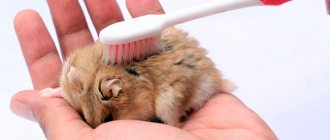Djungarian hamsters are domestic miniature, decorative rodents. Djungaric hamsters live from 1 to 4 years. Four years of age is considered a rarity among hamsters; such rodents are considered long-lived. Djungarians do not like being in sunlight for a long time; they are negatively affected by loud sound and bright fast clips on television. Diseases of Djungarian hamsters depend on the conditions of detention. Hamsters require a spacious cage, since the animals themselves are active animals, and they also do not tolerate the accumulation of garbage and excrement in their habitat.
In addition to the allotted life time by nature, proper nutrition has a great influence on hamsters. In this way, you can achieve a healthy life expectancy for the animal. Long-term research has revealed that their diet must include vegetables and fruits, namely carrots and zucchini. It is these two food products that contain the very elements that have a positive effect on the digestive system of Djungarian hamsters.
Habitats and how to arrange a cage. Diseases of Djungarian hamsters
Since some people keep Djungarian hamsters as a pet, their habitat is a cage or a specially equipped terrarium with oxygen supply. Thus, a person can easily track the life cycle of animals. There should be no high structures in cages and terrariums. These animals are so agile that they are sometimes clumsy, and this can cause further injury, for example, if they fall from a height. If a hamster falls, it can get bruises or scratches, which in turn can worsen, leading to more serious consequences. Close observation with due attention to the hamsters will give you the opportunity to promptly notice any deviations from the usual norm.
Let's together highlight some important aspects when arranging the future home of a dwarf hamster. The cage should contain a sippy cup, feeders, a house and wheels for games, since these animals, as mentioned earlier, are very mobile. The presence of stairs, tunnels and other household items at your request. Some people arrange the presence of two furious elevations in the cage.
These animals are not very endowed with the instinct of self-preservation by nature; only the close attention of their owners, as well as care for such a cute creature, will help prolong the life of the animal. If you once came up with the idea of getting a Djungarian hamster and you think that you will have no problems coping with such a small creature, then you are mistaken. Before getting an animal, it is worth talking with knowledgeable people who have experience in handling such animals. If you decide to give a gift to a child, then you should give a gentle lecture on handling and care. Any animal in the house is a great responsibility for their owners. The lecture will help you prevent your child from further disappointment.
Injuries and fractures
Hamsters are very small in size, but they are very inquisitive and active. That's why they get injured quite often. In addition, poor living conditions can cause injuries.
The hamster's cage should not be very high, because hamsters like to climb up the bars and do not fall very well from there, which can result in broken paws or even the spine. Thus, bird cages are certainly not suitable for hamsters, and cages with many floors can be very dangerous.
Lattice floors in cages and stairs are also dangerous. Running wheels with a large mesh can cause limb amputation. Plastic tunnels are dangerous not only because a hamster can suffocate in them, but also because hamsters often break limbs in them.
There should be nothing sharp in the cage. Large chips in the litter can cause damage to the eyes of hamsters. Do not put fabric, cotton wool or hay in the cage. Quite often it happens that large fibers cling to the hamster's paw, crush it, as a result of which it dries out and the hamster chews it off.
Serious open wounds can result from keeping two hamsters together or from attacks on small animals by other predatory pets. Cats often injure hamsters with their claws through the bars of the cage. Therefore, it is worth placing the cage in a place inaccessible to other animals.
A running ball is also very dangerous for hamsters. Many owners are interested in this kind of fun, but it can only bring harm to hamsters. In a running ball, while moving, the hamster does not have enough air, the animal overheats very much, and in addition, the hamster in the ball can crash into various obstacles, seriously injuring itself.
Another dangerous property of hamsters is that they have no sense of heights. The hamster may well jump out of your hands straight onto the floor and crash. Therefore, you must always handle your hamster with caution and monitor him very carefully. A fall from a meter height can very well be fatal for a hamster.
If the hamster is injured, in any case it must be taken to a veterinarian, who will carefully examine the pet and prescribe the necessary medications. Immediately after the incident, it is advisable to limit the hamster’s movements: remove the wheel from the cage, remove the floors, or better yet, completely transplant the pet into a smaller cage for the period of recovery.
Diseases of Djungarian hamsters and symptoms
In a sick hamster, symptoms usually appear immediately, since their metabolism is very fast, the presence of a wet tail, accompanied by diarrhea, blood discharge is also possible, which can subsequently bring such an unpleasant symptom to the animal as dehydration, which causes the body temperature to rise, and behavior changes to the point of complete lethargy. Next comes death. All diseases with complications can worsen and move into other phases of the disease, building a whole chain of unpleasant painful events.
Diseases of Djungarian hamsters are varied, let's look at some of them.
1 Mechanical injuries or bruises, fractures, scratches and even fainting occur as a result of a fall from a height or during the manifestation of your boundless love for a rodent. Such falls are fraught with bruises to internal organs. Symptoms include a painful appearance of your animal, namely problematic movement and twisted limbs.
2 Colds - here, in general, the disease and accompanying symptoms are characteristic, as with any living creature. The activity of the animal is reduced, pain is accompanied by sneezing, snoring, and lack of appetite. It is easy to notice the presence of the disease by the low activity of the hamster.
3 Eye diseases - conjunctivitis, purulent discharge, sticking of the eyelids. A visual examination of the animal will give a complete picture of the presence of the disease. But there is also an incurable disease called cataracts in the eyes of a hamster. In this case, the animal requires much more care and attention.
4 Another common problem is the problem with the teeth of a rodent; excessive growth in the length of the teeth interferes with the life of hamsters; also, due to mechanical injuries, any parts of the teeth can be damaged. To identify this disease, it is enough to conduct a visual examination.
5 Skin and coat diseases - dermatophytosis and eczema are accompanied by skin exfoliation and hair loss. This disease is very easy to identify by performing a visual examination.
6 Intestinal diseases - an upset stomach of the baby is accompanied by loose stools and an unpleasant odor.
7 And finally, the most common problem is the formation of lumps; many owners have the opinion that a newly formed lump is a cancerous disease. Don’t worry, it’s important to contact a qualified specialist who will accurately determine your pet’s disease. Perhaps it was an unfortunate injury from a fall.
8 Constipation - improper feeding, lack of moisture and dry food contribute to poor digestion. The disease can be identified by highlighting the symptoms - small droppings in the cage, other forms of bending during bowel movements, the animal makes a squeak. Also loss of appetite.
9 Allergies - such a small creature is also susceptible to allergic reactions. The symptoms are similar to those in humans - sneezing, itchy nose, liquid discharge from the mucous membranes of the eyes and nose.
10 Shedding - in general, this cannot be called a disease if we assume that shedding is inherent in nature, but there are also pathological complications when the fur comes off due to a lack of vitamins in the animal’s body.
11 Obesity is not so much a disease as it is an oversight of the owners. By pampering his animal with goodies, the owner of the hamster, without knowing it, dooms him to gain excess weight, which in turn causes shortness of breath and great stress on the heart. Fat hamsters don't live long.
At home, the diseases that will now be described are quite rare, but it is still better to be prepared for any ailment of the domestic dwarf. And let's look at it like this:
- Rabies - the hamster begins to behave aggressively, squeaking and biting for no reason.
- Tuberculosis - makes hoarse moans, breathes heavily. Weight loss and decreased activity.
- Parasites Ticks - itching, wounds, hair loss, rodent squeaking, abscess.
- Listeriosis - fainting, loss of coordination.
- Tizzer's disease - severe diarrhea, apathy, the hamster is shaking.
Localization of neoplasms
Tumors in hamsters can grow anywhere. And the sooner you find it, the higher the chance of saving the fluffy. Therefore, periodically inspect and carefully feel the tiny body. Here are the most common places where a lump can grow:
Internal cancer clusters are almost impossible to detect in the early stages
Therefore, let's pay attention to the external inspection
Bumps on the head and neck
Viral and bacterial infections provoke inflammation of the cervical lymph nodes in hamsters. This condition is painful, it causes a plaintive squeak in the dwarf. But the pet does not always give a signal to the owner that he is unwell. What symptoms indicate that a tumor in a hamster's neck is causing him discomfort? Firstly, the pet will eat very little, as it hurts to swallow. Secondly, you will notice that he is trying not to turn his head. Having noticed these signs, touch your pet’s neck on both sides under the cheekbones: the inflamed lymph nodes feel like hard balls.
Often, a thickening similar to gumboil appears on the hamster’s face. A tumor on a hamster's cheek indicates inflammation of the oral cavity. This condition can be provoked by too hard food with jagged edges that scratch its cheek pouches (which is why fluffies should not be given fruit tree seeds). Pathogenic bacteria actively multiply in the wounds, causing such severe inflammation that the cheek swells. Sometimes the cheek is so badly damaged that the homa cannot open his eyes.
The photo shows how the hamster's cheek is swollen.
Sometimes animals suffer from eye problems. Conjunctivitis is characterized by suppuration of the eyes and a burning sensation. The hamster keeps trying to scratch his eyes, making the situation worse. If a hamster's eye is swollen, then its owners are to blame. Bedding in a cage that has not been changed for a long time is the surest source of pathogenic bacteria that cause conjunctivitis.
Paw diseases
If your pet is handled carelessly, he may suffer a fracture, bruise or dislocation. True, the owners are not always to blame for the animal’s injuries. He himself is capable of injuring himself by unsuccessfully jumping from the second tier of the cage. Therefore, if your hamster's paw is swollen, a veterinary examination should be performed.
But it’s not only trauma that can cause swelling of a limb. Sometimes furry cats get osteosarcoma, a viral disease that causes bone tissue to grow and surrounding areas to swell. At first, the animal becomes inactive, and the affected limb swells in a matter of days. Inflammation covers the entire limb, then spreads to the torso. Unfortunately, this viral disease has no cure yet.
A slight swelling on the animal's toes may be caused by a splinter. Therefore, veterinarians do not recommend using small sawdust as bedding.
Tumors on the trunk
Sometimes rodents develop tumors on the ventral side of the body. It has been established that tumors in a hamster’s abdomen are more often localized in the mammary glands. The disease is more typical for sexually mature females and can be benign or malignant. Since this is not an intracavitary neoplasm, it can be removed.
Papillomas may appear on the animal’s stomach and armpits. The proliferation of skin tissue is caused by the activity of viruses. The skin disease develops gradually: first, tiny tubercles appear, which over time turn into benign growths similar to warts. If they are not removed, they can grow up to 2 cm, and for the small body of a hamster this is a very noticeable size.
Swelling may also appear under the tail. Many upset owners bring their little one to the veterinarian and complain that the hamster’s butt is swollen and fur has come out in this place. And then they rejoice when the doctor assures them that their pet is a boy, gradually turning into a man. But if Khoma is already old enough, and his butt suddenly starts to swell, it’s still worth going to the doctor. Even hamsters are not immune to testicular cancer.
Treatment of disease in Djungarian hamsters
By contacting the Ya-Vet veterinary center, we will provide you with full qualified assistance, help you console yourself and cure your rodent, and you can also use the service of calling a doctor at home. The experience and professionalism of our specialists will satisfy all your requirements, and the price will pleasantly surprise you.
After a complete examination, the veterinarian may prescribe home treatment for the animal. Let's look together at what a hamster owner can handle on his own.
- If you have a cold, it is enough to give your hamster more fruits that contain vitamins; they, in turn, will stimulate the functioning of the animal’s immune system. Thus, with a minor cold, your hamster will return to normal in a couple of days.
- In case of eye disease, it is enough for the rodent owner to rinse the eyes with lightly salted water several times a day.
- In case of mechanical damage to the teeth or their shortening, you should contact veterinary centers for qualified help; in many cases, the diagnosis and its solution can only be made by a highly specialized specialist.
- Diseases of the skin and coat are varied; hair loss can be triggered by a state of shock, fear of the baby, or prolonged stress, pay attention to this. There may also be parasites on the skin of the animal - ticks and lice; special sprays and ointments will help us deal with this problem.
- For disorders of the gastrointestinal tract of the Djungarian hamster. It is enough to change his diet, pay attention to the foods he eats.
- If tumors and lumps are detected, immediately contact a veterinary center, only there they will give you an accurate diagnosis and offer the right path to solving the problem.
- Constipation is treated by adding a drop of vegetable oil to the food; it softens the solid mixture and forms a soft effect on the walls of the stomach. Also, the addition of fiber (fruits, vegetables) will accompany you on the way to a good passage of the intestinal tract.
- Allergies in a hamster can be caused by unsuitable food, sawdust in the cage, or bedding materials.
- Molting is treated by normalizing nutrition, including vitamin-rich foods in the diet and adding yeast to the water.
- If you have an obese hamster, then treatment is completely in your hands; the right diet and exercise will get your pet in shape.
Worms and parasites in hamsters
You brought home a tiny hamster, take care of it, feed it the right food, give it vitamins, but one day you notice that something is wrong with your pet? The hamster has become lethargic, he has a poor appetite - perhaps your rodent has... worms. Unfortunately, these parasites are quite common in the body of hamsters and must be dealt with. How? We will talk about this in our publication...
How to call a veterinarian at home
At the Doctor-Vet veterinary clinic, you can call a ratologist to your home to provide emergency care throughout the Moscow region. We work seven days a week and seven days a week, and are ready to answer additional questions - call 8(495) 226-19-44. A veterinarian will go to your address and provide advice and care recommendations.
Clients will appreciate:
- Prompt response to incoming applications;
- Comfortable transportation of patients, which will protect them from stress;
- Competent veterinarians with many years of practice who know their business well;
- Use of high-quality, effective medicines;
- Availability of modern mobile equipment and necessary tools for a wide range of procedures;
- Favorable prices;
- Possibility to use the service at a convenient time.
| Service | Price |
| Calling a veterinarian to your home | 600 ₽ |
| Filing of canines and incisors | 200 ₽ |
| Filing of cheek teeth | 1000 ₽ |
| Reduction of the cheek pouch | 500 ₽ |
| Vaccination | from 600 ₽ |
Do hamsters have worms?
We all know that worms can parasitize the body of animals, birds, and people. And, alas, our pet hamsters are not immune from such internal tenants. Their presence in the rodent’s body is harmful to the health of your little pet, since worms absorb all the nutrients that the hamster receives along with food, they multiply in his body, and as a result of their vital activity, they release toxic substances and toxins that can lead to intoxication of the body, leading to exhaustion of the hamster and, ultimately, to its death. A rodent, weakened by the existence of such parasites inside it, has a harder time resisting viruses and infections, and the slightest cold can end sadly for it. Read more about hamster diseases.
Medicines for weak hamsters
Sometimes situations happen that the hamster still gets sick. This may be the cause of his birth defects, not necessarily due to poor care or oversight.
A veterinarian should prescribe medications; it is unsafe to treat a hamster with medications yourself.
The animal's body is much smaller than that of a human. Only a specialist can make an accurate calculation of the portion of a medicinal product or medicinal supplement (vitamins) for an animal based on age, weight, and state of weakness (immunity).
Don't take risks with your pets. Seek advice from specialized institutions.
How to determine if a hamster has worms
A stool test will help determine the presence of worms.
Almost all hamsters have worms. To be sure, you can take your pet's stool to a veterinary laboratory for testing. Both flat and round tapeworms can be found in it.
If you can’t see a veterinarian, and you doubt whether your pet has worms, take a closer look at him. If your little hamster has become inactive, it often shows signs of anxiety, its fur looks unkempt, it has problems with bowel movements, hair loss or the formation of ulcers on the skin is possible, trembling periodically runs through the hamster’s body, previously tame, it suddenly began to show aggression, it has deteriorated appetite, and he looks sick and exhausted - most likely we are talking about a helminthic infestation. Although, perhaps the above symptoms also indicate the presence of other diseases in the rodent. Only a veterinarian can answer this question accurately, after examining the rodent’s stool for the presence of parasites.
Oral and eye problems
Hamsters' teeth are constantly growing, and this can cause certain problems. There should be something in the hamster's cage that the hamster will grind its teeth on. These can be tree branches: birch, cherry, peach, apple trees, a wooden house or a tunnel. It happens that a hamster does not have time to grind down its teeth, and they grow too large, interfering with the normal life of the animal. In this case, you can only help by cutting your teeth. Under no circumstances should you do this yourself - you need to contact a veterinarian.
As a result of injury or illness, a hamster can lose teeth, this especially often happens in older animals. You can only help by offering your pet soft cereals or baby purees as food, since the hamster is unlikely to cope with solid food.
It is also quite common for hamsters to have problems with their cheek pouches. The cheek pouch may become clogged, the hamster will not be able to remove food from there, and it will begin to rot. Wounds and tumors, loss are also possible. In this case, the hamster begins to refuse food, his eyes become watery, and he loses weight. Only a specialist can help.
Another vulnerable spot in hamsters is their eyes. Eye diseases in hamsters can lead to complete blindness. They often suffer from conjunctivitis. The cause may be illness (salmonellosis, infectious pneumonia) or injury. The hamster's eyelid swells, the eye waters, pus is released, and the affected eye does not open.
Another common eye disease in hamsters is cataracts. The eye becomes cloudy, and a white spot can be seen in the place of the pupil. In this case, partial or complete loss of vision is possible.
Are hamster worms dangerous for humans?
Since you often pick up a hamster in your arms, clean its cage, and do not always remember the rules of personal hygiene after contact with the pet and its things, it is likely that you can become infected with worms from the hamster. Much has been said about the consequences of helminthic infestation for the human body, and we will not repeat ourselves. Let's just say that worms do not add health to either you or your pet. Therefore, in order to get rid of them and prevent their appearance, you definitely need to take certain measures.
Treatment of worms in hamsters
How to rid a hamster of worms
Following the dosage prescribed in the instructions, using a special syringe without a needle (it comes with the medicine), carefully inject the specified amount of anthelmintic suspension into the rodent’s mouth, making sure that the pet does not choke. That's all. Following the recommendations from the instructions, do not forget about the prevention of worms in your hamster.
Video about hamsters
Today we talked about worms in hamsters, the prevention and treatment of these parasites. We hope that our publication will keep your pet healthy. Do you deworm your hamsters? Share your experience with us.
We are waiting for your feedback and comments, join our VKontakte group!
Can a hamster get external parasites - fleas, lice, lice and scabies mites? Hamster owners don’t ask this question very often, and only when faced with the problem directly do they learn a lot of new and sometimes unpleasant things.
Cold
The first thing you need to know is that hamsters are very afraid of drafts and cold. It is not allowed to place the cage in a place where the air conditioner is directed or very close to a window. You should not take your hamster outside even in warm weather. A slight breeze is dangerous for a pet that is not accustomed to sudden changes in temperature. If the background temperature of the room where the pet is located has dropped sharply, you should think about heating the hamster. A cold is a rather dangerous disease for a hamster, and it should be treated immediately when the first symptoms appear, otherwise complications can lead to the death of the animal.
A hamster should never be bathed in water, otherwise it can easily catch a cold. Hamsters clean their fur in special sand, not in water. Large open drinking bowls are also dangerous for hamsters, as they can cause the hamster to get wet and get sick. It is advisable to provide hamsters with ball or nipple drinkers.
A hamster can get the flu from a person. During illness, it is advisable to reduce contact with the animal to a minimum.
The main symptoms of hamster disease:
- discharge from the nose and eyes;
- the hamster often sneezes and rubs its nose with its paw;
- the animal is breathing heavily.
If your hamster shows signs of a cold, you need to urgently take care of its temperature. The optimal temperature is 21-25 degrees. It is worth temporarily removing the wheel from the cage and providing your pet with absolute peace. It is necessary to show the hamster to a veterinarian and provide him with proper treatment.
Sneezing can be a sign not only of a cold, but also of an allergy. The strongest allergen is pine sawdust, which owners often unknowingly put in the cage as filler. This should not be done under any circumstances! Even if it initially seems that pine needles have no effect on your pet’s health, it is worth knowing that the harm of the allergen tends to accumulate. As a result of exposure to pine needles, the hamster's hair may fall out, and serious problems will begin with the respiratory tract.
Fleas, lice and lice in hamsters
Fortunately, these parasites are rarely found in rodents. Hamsters can become infected with them if they come into contact with other animals affected by parasites, for example, a cat or dog. You can determine the presence of parasites in the fur of a small pet visually by parting a section of fur, as well as by the constant itching that the hamster experiences. But in general, the rodent’s behavior does not change, nor does its appetite.
You can rid your hamster of parasites using modern antiparasitic agents sold in pet stores or veterinary pharmacies.
Important: a week after the first treatment, the procedure must be repeated in order to destroy the hatched larvae (unless otherwise provided in the instructions for the drug). It is also necessary to treat the hamster cage and all the accessories in it. For treatment, you can use a bromocyclene solution.
Scabies in hamsters
Scabies is a fairly common disease. It is caused by small parasites – scabies mites. They are so small that it is simply impossible to see them with the naked eye.
There are several types of scabies mites:
1) parasitic on the upper layer of the skin (also called itching);
2) cuticles, piercing the surface of the skin and getting to the blood and lymph, which is sucked;
3) skin beetles, which feed on dead areas in the form of dandruff that form on the skin.
These parasites pose a threat not only to the health of the hamster, but also to the person who has come into contact with the infected animal or objects from its cage. An animal can become infected only from a sick animal or through objects from an infected cage.
- severe itching;
- scratching areas of skin until they bleed;
- hair loss;
- local baldness;
- in the area of the cheeks, ears and anus a crust appears in the form of a coating of powder, similar to scales;
- loss of appetite;
- apathetic, depressed state;
- aggressive behavior.
Untimely treatment of a hamster affected by scabies mites leads to infection of the wounds scratched until they bleed, and the animal may die in a couple of months, and in especially severe cases, the count goes on for weeks.
In this case, independent treatment is unacceptable; a consultation with a veterinarian is required with laboratory tests and a course of treatment, including thorough treatment of the cage and all items from it. The owner of a hamster should be aware that treatment is carried out with antiparasitic drugs, which should be calculated by the veterinarian, taking into account the weight of the pet, but still very often during the treatment there is a high risk of intoxication.
Can a hamster have worms?
Internal parasites - worms - very often parasitize animals, and hamsters, alas, are no exception. You need to be wary if your pet shows anxiety for no apparent reason, has become not as active as before, problems with stool are common, tremors periodically pass through its body, previously tame, the hamster suddenly begins to show aggression.
The presence of parasites can be determined in a veterinary laboratory using stool analysis. If the fears are confirmed, the pet should be treated immediately, since worms can cause severe intoxication of the animal’s body. It is best to contact a veterinarian for help, since, given the small size of the rodent, only a specialist can correctly calculate the dosage of the anthelmintic drug.
This is the name given to parasites (more than 10 different species) that live in the tissues and organs of an animal. They belong to the classes of trematodes, cestodes, and nematodes.
Intestinal diseases can provoke cestodes; trematodes affect the liver, gall bladder, and bile ducts. Nematodes parasitize various internal organs and cause severe illness.
There are 2 types of worms: tapeworms and roundworms. Round ones are usually similar in shape to white or pink threads. They parasitize in the lungs, liver, and intestines.
Upon careful examination of the feces of a sick animal, you can notice the testicles of worms. Infection occurs when hamsters are fed stale food, through contact with a sick animal, or through dirty water. It is necessary to conduct tests to find out what type of parasites are in the pet’s body and begin appropriate treatment. To do this, you need to contact a veterinarian.
Tapeworms consist of individual small segments and have the appearance of a thin ribbon. Those segments that are located further from the head of the parasite are better developed; larvae develop in them over time. These segments then break off and come out along with the feces.
When the membranes of the testicles, which have entered the digestive tract of the animal, break through, the embryos of the parasites can damage the intestinal walls, enter the bloodstream and disperse throughout the body. This sometimes causes the appearance of entire cavities in the internal organs of the animal, which are filled with embryos of worms, which pose a danger not only to animals, but also to humans.
Some types of helminths come out with feces and enter the animal’s body again, only as adults, along with food and water.
Hamsters are most often affected by tapeworms Hymenolepis nana and Hymenolepis diminuta, roundworms Heterakis spumosa, pinworms, and worms of some other species.
Tapeworms undergo a developmental cycle with an intermediate host, such as an insect. They cause severe invasive diseases in domestic animals. As a result of severe damage, exhaustion of the body develops.
Roundworms are localized in the cecum.
When infected with pinworms, intestinal disorders are sometimes observed, but most often there are no special symptoms.
Like all living creatures, hamsters are susceptible to disease. Their life is short, and the disease in hamsters always progresses very quickly. Therefore, it is important to notice in time that something is wrong with your pet and quickly provide help. Find out in advance where the veterinarian who treats ornamental rodents sees you. It would be a good idea to study the symptoms of diseases to which hamsters are susceptible. This will not only increase the chances of saving the baby, but will also help avoid infection yourself. After all, a person can become infected with many diseases from animals. People can get the same disease that hamsters get. This article tells you what diseases afflict Syrian, Djungarian, Campbell and other breeds of hamsters.
Diabetes
The big danger that Campbell's hamsters are exposed to is diabetes. This type of hamster is very sensitive to sugar contained in food, so when feeding you need to adhere to a diet. Hamsters should not be given carrots, pumpkin, dried fruits, sweet fruits and berries. Corn is dangerous for them.
It is worth noting that purebred Djungarian hamsters do not have a predisposition to diabetes. However, there are frequent cases of crossing Djungarian hamsters and Campbell's hamsters by inexperienced breeders who kept these species together because of their great similarity. Nowadays it is very difficult to find purebred Djungarians. Due to the Campbell's tendency to diabetes, this disease often manifests itself in Djungarian hamsters. If the breeder has not provided you with your hamster's pedigree, it is best to stick to a diabetic diet. Otherwise, the diseases of Djungarian hamsters and treatment are no different from other species.
One of the main signs of diabetes is that the hamster begins to drink a lot of water. It is usually extremely difficult to catch them drinking water, because they do it infrequently. If suddenly your hamster constantly quenches his thirst, this is a reason to sound the alarm. A test for diabetes can be done at home - human tests that can be purchased at a pharmacy are suitable for this.
Thus, diabetes mellitus is extremely dangerous not only for Campbells, but is also a fairly common disease in Djungarian hamsters, and its treatment is impossible. If you do not adhere to the diet, the hamster dies quite quickly. If you seriously take care of your hamster’s nutrition and eliminate all dangerous fruits and vegetables from its diet, you can extend the life of a pet with such a diagnosis.
Hamster diseases are very diverse, and they can easily become fatal if you do not seek help from a veterinarian in time. The main prevention of disease is maintaining proper living conditions for the animal. In any case, if you suspect that your pet is ill, you should not leave everything to chance, because the life of your hamster depends only on you.
Classification of diseases
According to the type, hamster diseases, like those in humans, are divided into contagious and non-contagious. The following diseases are contagious.
- Bacterial infections. Cause gastrointestinal, skin and other inflammatory processes.
- Viral infections. They affect the eyes and mucous membranes and cause tumors.
- Fungal. Mainly they cause skin diseases.
- Infection with parasites (fleas, ticks, worms).
Some of these diseases can be transmitted to people. You need to be extremely careful when contacting a sick animal and take it to a veterinarian as quickly as possible. Only a doctor, after performing tests, will make a final diagnosis and give a prognosis for the possibility of recovery. Unfortunately, many diseases are fatal to a hamster. But in any case, a loving owner will do everything in his power to ensure that the hamster recovers.
Non-communicable diseases include non-communicable diseases.
- Injuries and bruises caused by falling from a height or fighting with other cage occupants.
- Metabolic disease. For example, diabetes mellitus, which most often affects Djungarian hamsters.
- Diseases caused by stressful situations. These include heart disease, heart attacks, and strokes.
Diseases in Syrian hamsters are most often associated with gastrointestinal infections.
Skin problems
Bald patches, wounds, irritation, dandruff and flaking that appear on a hamster are all that the owner should pay close attention to. These manifestations may indicate many different diseases.
Possible reasons:
- Quite often, hair falls out on the face if the hamster chews on the bars of the cage. This often happens if the cage is too small for the hamster, and he tries with all his might to get out of it. In this case, it is necessary to transplant the hamster into a large cage as soon as possible. If the size of the cage already meets the standards, it makes sense to transplant the hamster into a food container with properly ventilated and allowed dimensions, or into a dune cage, the bars of which are located only at the top, while the rest of the space is occupied by smooth plastic.
- A common cause of hair loss is an allergy to pine needles. In this case, the pine filler must be replaced as soon as possible. Non-allergenic for the hamster: fruit tree sawdust, corn and cellulose filler.
- All kinds of mites can cause hair loss, skin inflammation, dandruff and itching. A veterinarian can detect their presence by doing tests.
- A fungus that can only be detected by a veterinarian.
- Problems with internal organs. In almost all animals, diseases of the internal organs immediately affect the condition of the coat. It begins to look dirty or greasy and falls out in clumps.
It is worth noting that long-haired Syrian hamsters require much more attention to the condition of their coat. The fur can become matted, causing irritation on the skin. For long-haired hamsters, it is better not to put sawdust as litter in the cage, otherwise it will get stuck and tangled in the fur. Otherwise, the diseases of Syrian hamsters and their treatment are the same as those of other species.
If your hamster begins to have problems with its fur or skin, you should first make sure that there are no errors in the living conditions. If this is all right, you should take your hamster to the veterinarian to determine the exact cause of the problem. It must be remembered that symptoms that seem not particularly dangerous can be a sign of a serious illness that can be dangerous for humans.
When to sound the alarm
How to understand that a hamster is sick. If the animal is healthy, it is active, it has smooth shiny fur, clear, clean eyes and a good appetite. But if you notice that your pet is behaving unusually, take immediate action. Your hamster is sick if some of the following symptoms are noticeable:
- eats poorly or refuses food altogether;
- eyes become watery or festering;
- frequent loose stools;
- constipation, dry stool or no stool at all;
- blood dripping from the anus;
- difficulty or hoarse breathing, cough;
- nasal discharge or excessive drooling;
- wet or dull, matted fur;
- ulcers, wounds, peeling skin, bald spots on the skin;
- tumors, bloating;
- lethargy, low mobility;
- the hamster is trembling, although the room is warm.
An animal's underweight may also be a sign of illness. To find out if your pet is sick, weigh your pet periodically. The weight of an adult Syrian is about 90 g, the weight of a Djungarian is at least 30 g.
Contagious diseases in hamsters
An animal can become infected with a bacterial or viral infection in several ways.
- From other sick animals through direct contact or through its waste products.
- Through contaminated food or water.
- Insect bites.
- Through litter and uncollected excrement.
Respiratory infections are activated by hypothermia, stress and lack of vitamins in the body. You can tell that a hamster is sick by its behavior. He will become lethargic and apathetic. You may notice discharge from the nose. The young, strong hamster will recover in a few days. In weak individuals with reduced immunity, the disease can develop into pneumonia. The animal will cough and breathe heavily. In a few days he will die.
Tuberculosis develops in a weakened body when the tuberculosis bacillus enters the body. There are two forms of this disease, depending on the method of infection: pulmonary and intestinal. With the pulmonary form of tuberculosis, the hamster experiences a cough, shortness of breath, and decreased appetite. The intestinal form is characterized by severe diarrhea. This disease of hamsters, unfortunately, is incurable.
To prevent tuberculosis, the animal must receive adequate nutrition with the required amount of vitamins, the cage must be kept clean at all times, and the room must be periodically ventilated. It is necessary to avoid contact with sick animals and people. Not only can humans become infected with certain illnesses from a hamster, but rodents can also suffer from contact with a sick person.
Colibacillosis is a highly contagious disease. If the sick animal has been in contact with other pets, they will also have to be treated. The sooner you see a doctor, the more successful the treatment will be. Prevention of the disease - maintaining cleanliness in the cage. As well as keeping each animal in a separate cage.
Cystitis. A wet tail can be an indicator not only of colibacillosis, but also of cystitis - inflammation of the genitourinary tract. The animal experiences pain when urinating and is constantly thirsty. The disease occurs from hypothermia. Maintain the optimal temperature in the room where the baby lives, do not place the hamster’s cage in a draft. Cystitis can also be treated with antibiotics.
Diplococcosis is an infectious disease of the respiratory tract caused by diplococcal bacteria. Symptoms: weakness, lethargy, refusal to eat. The hamster is shaking and trembling, and his nose is running. Death occurs within 2–3 days if a special antibacterial serum is not administered in time.
Salmonellosis is an acute intestinal disease caused by Salmonella Escherichia coli. It also leads to death if treatment is not started in time.
Pneumonia is a common complication after respiratory infections if the patient does not receive proper treatment and proper nutrition. Or if the animal has a lack of vitamins in the body and lowered immunity. The disease can occur after severe hypothermia.
Conjunctivitis is an inflammatory process of the eyes and eyelids. Eye diseases in Djungarians occur from hypothermia or are of a bacterial nature.
Demodicosis is a disease caused by a microscopic subcutaneous mite. The animal itches and the hair falls out. The disease is treated with an injection of ivermectin.
Ringworm is a fungal disease. Scaly spots appear on the body and limbs of the rodent, and the fur falls out. The disease is contagious and can be transmitted to humans. The doctor will make a scraping and prescribe treatment with ointments and special creams.
Non-communicable diseases
Non-contagious diseases of Djungarian and other breeds of hamsters primarily include injuries. They are injured mainly due to the fault of their owners. Rodents should not be allowed to walk on a table or other surface from which the homa could fall. When purchasing and installing a running wheel, it is necessary to exclude narrow (less than 0.5 cm) gaps so that the baby does not stick his paw in there and injure himself. If you have several dwarfs, place them in different cages. Otherwise, they will fight and may also injure each other.
Poor nutrition may be the cause
- dental diseases;
- inflammation of the cheek pouches;
- food poisoning;
- hemorrhoids (if blood drips from the anus, your pet may have a fissure there).
Non-communicable diseases also include complications of pregnancy and pathological childbirth in females. Sometimes blood under the female's tail appears as a result of a miscarriage.
Veterinary services for rodents
The treatment for each individual animal is different, which is why it is so important to contact specialists. Depending on what kind of therapy the pet needs, an individual research program is prescribed. We conduct:
- Scheduled and preventive examinations;
- Complete diagnostics of the body;
- Collection of analyzes;
- Trimming, teeth straightening;
- Nail trimming;
- Tartar cleaning;
- X-ray;
- Catheter installation;
- Castration and sterilization;
- Vaccination against various diseases;
- Ultrasound;
- Operations.
Metabolic disorders
Metabolism is the proper functioning of all body systems. Food processing, energy production, removal of unnecessary and harmful products. The central nervous system is responsible for all this, but the glands that secrete hormones have a huge influence on metabolic processes. These include the thyroid and pancreas, adrenal glands, pituitary gland, and gonads. Poor nutrition, poor environment, and hereditary factors affect the functioning of these organs. Violation of their normal functioning leads to a malfunction of the body as a whole. Diseases of Djungarian hamsters are often associated with metabolic disorders.
Diabetes mellitus can develop due to excessive consumption of carbohydrates. Hereditary predisposition to the disease also plays a role. You can find out that a hamster has contracted this disease by the characteristic smell of acetone, which comes from the rodent's saliva and urine. But only a doctor can make a final diagnosis by doing a blood test. Prevention of disease in Djungarian hamsters is a balanced diet, eliminating sugar from the diet, good care and an active lifestyle.
Stroke can also be classified as a disease that occurs due to metabolic disorders. With age and as a result of poor nutrition, cholesterol plaques are deposited on the walls of blood vessels, which prevent the normal passage of blood. At some point, the plaques completely block the vessel, it bursts, and hemorrhage occurs.
If your hamster is shaking or having convulsions, the end is probably near.
Sometimes attentive owners are concerned that the rodent has a yellow sore on its stomach. In fact, this is a scent gland, with the help of which the male marks his territory.
Problems with internal organs
Some problems may be invisible to the naked eye, because they are hidden inside the animal's body. We will analyze diseases of hamsters associated with dysfunction of internal organs, symptoms and treatment.
Due to improper feeding, hamsters quite often develop problems with the gastrointestinal tract. Diarrhea or constipation, bloating, and grumbling are the main signs of problems.
A common disease in hamsters is wet tail. This occurs during an infectious disease. As a result, the hamster begins to have severe watery diarrhea, and the fur under the tail is constantly wet. The hamster becomes aggressive, stops eating, and starts bleeding. In this case, the animal must be shown to a doctor.
As a result of consuming low-quality food, a hamster can become poisoned. He may have vomiting and diarrhea, refusal to eat, and loss of coordination.
Another common disease in hamsters is salmonellosis. The animal refuses to eat and has severe diarrhea with yellow feces. Severe bloating occurs. The hamster hides in the house and does not come out.
Obesity and an insufficiently active lifestyle can cause heart problems. Another reason could be severe stress. It is advisable to keep your hamster in a place away from other pets, otherwise he may be constantly nervous, which will adversely affect his health.
The small size of a hamster's home can lead to problems with the nervous system and psyche. Nervous disorders can lead to limb failure, behavior changes, and aggression.
A common disease in domestic hamsters is cystitis or urolithiasis. The main signs: the hamster squeaks when urinating, blood is visible in the urine. Clean drinking water should be freely available in the cage at all times.
Hamsters can get rabies. Of course, the chances of infection in hamsters are small, but still, if a hamster suddenly becomes very aggressive, his fur is disheveled, he does not drink water at all, you should be very careful with your pet.
Diseases caused by stress
Stress factors for a small rodent can include loud screams, the operation of various electrical appliances, other pets and much more. Diseases that develop as a result of stress in Syrian and other breeds of hamsters:
- eczema (ulcers and peeling of the skin, hair loss);
- heart attack, cardiac arrest;
- complete or partial paralysis (can occur if the animal is very frightened).
To avoid such troubles, never yell at your baby or punish him for any pranks. Do not place the cage near a TV or speakers. Isolate the rodent from cats and dogs if they live in your home. If you just acquired a furry puppy, give him a few days to get used to his new place of residence, do not immediately start playing with him or raising him.











